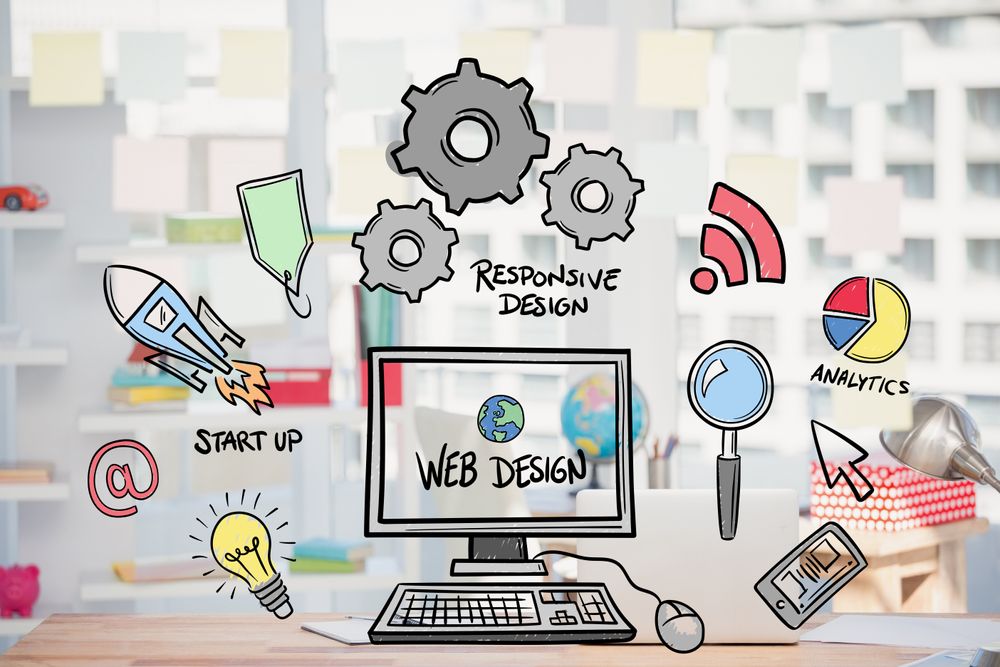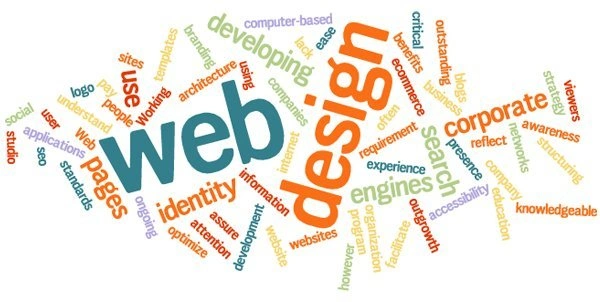The role of feedback and analytics in improving Web Design Agency performance
Wiki Article
Checking Out Innovative Fads in Web Design for Modern Companies
The landscape of web design is consistently evolving, mirroring the vibrant needs of modern-day organizations. Current patterns highlight a preference for minimalism, vibrant typography, and interesting interactivity. Firms significantly focus on user experience through mobile-first concepts and individualized material. Furthermore, a concentrate on sustainability is obtaining grip. Understanding these trends is essential for organizations aiming to stand apart in a jampacked industry. What ramifications do these shifts hold for the future of digital engagement?Welcoming Vibrant Typography
Strong typography has become a defining component in contemporary web design, capturing focus and sharing messages with striking clearness. This pattern prioritizes visually impactful text that enhances user involvement and brand identity. Designers usually use oversized font styles and distinct typefaces to produce a hierarchy, guiding customers via material effortlessly.
The calculated usage of bold typography enables for effective storytelling, making it possible for brands to connect their values succinctly. It serves not just visual purposes but likewise functional ones, as it boosts readability across devices and display sizes.
As sites compete for user interest, strong typography stands out in a saturated digital landscape. Its flexibility enables developers to experiment with contrasting designs and colors, better amplifying its efficiency. Eventually, accepting bold typography represents a shift towards more expressive and communicative web design, cultivating a much deeper link in between brand names and their target markets.
The Surge of Minimalist Design
As digital environments become significantly chaotic, the rise of minimal style provides an invigorating option that focuses on simpleness and performance. This style ideology remove unnecessary components, permitting material to take spotlight. By concentrating on tidy lines, ample white space, and a limited shade scheme, minimal design enhances user experience and boosts navigating.Organizations adopting this trend aim to convey their brand name message plainly and efficiently, fostering a sense of calm and clearness. The lack of diversions assists users concentrate on necessary information, leading to improved interaction and conversion rates. Furthermore, minimalist layout lines up well with mobile-first methods, making certain that websites remain user-friendly and easily accessible across numerous gadgets.
Ultimately, the surge of minimalist style reflects a wider shift in the direction of prioritizing user needs and preferences, making it an effective tool for contemporary services seeking to make a long lasting impact in the digital landscape.
Immersive Animations and Interactivity
While several internet designers accept minimal appearances, an additional compelling pattern acquiring traction is the usage of immersive computer animations and interactivity. This technique boosts user engagement by creating appealing experiences that attract site visitors into the material. Developers utilize vibrant elements such as animated histories, scrolling impacts, and interactive infographics to connect complicated concepts in an easily accessible way.These computer animations not only supply visual passion however likewise guide users through the navigation procedure, making communications much more user-friendly. For example, hover impacts and animated shifts can encourage users to discover further, causing increased time spent on the website.
This fad straightens with the more comprehensive activity towards storytelling in web style, where computer animations offer as narrative devices that communicate brand name messages efficiently. By integrating immersive computer animations and interactivity, services can differentiate themselves in a congested online landscape, eventually boosting user complete satisfaction and brand commitment.
Mobile-First Style Principles
Mobile-first layout principles emphasize focusing on user experience by making certain sites function flawlessly on smaller displays. This technique integrates receptive design techniques that adapt to numerous device dimensions while maintaining aesthetic integrity. Additionally, it concentrates on touchscreen navigating style, boosting usability for mobile customers.Prioritizing User Experience
How can designers efficiently focus on user experience in an increasingly mobile-centric globe? Emphasizing mobile-first style concepts is vital, as customers mainly involve with web sites with mobile gadgets. This strategy encourages designers to simplify content, ensuring it is navigable and conveniently obtainable on smaller screens. Trick methods consist of streamlining navigating, reducing lots times, and utilizing touch-friendly aspects that improve interactivity. Furthermore, prioritizing understandable typography and instinctive designs can substantially enhance user contentment. Designers should continually collect user feedback to fine-tune their techniques, adapting to developing user requirements and preferences. By focusing on these components, services can produce an interesting digital experience that cultivates commitment and drives conversions, inevitably lining up with the assumptions these days's mobile customers.Receptive Format Methods
Developers welcome receptive layout techniques to create versatile and adaptive web experiences that deal with various display dimensions. This method prioritizes mobile-first design principles, ensuring peak functionality on smaller sized devices prior to scaling up for larger displays. By utilizing fluid grids, versatile images, and media queries, developers can preserve a natural visual identity across all platforms. This method not only improves user interaction yet likewise enhances search engine positions, as mobile-friendly sites are favored by search formulas. Additionally, responsive layouts allow organizations to get to a broader audience, fitting individuals on tablets, desktops, and mobile phones alike. On the whole, executing these techniques is essential for contemporary web design, ensuring that organizations continue to be affordable in an ever-evolving digital landscape.Touchscreen Navigating Layout
With the surge of mobile gadgets, touchscreen navigation has become a basic facet of web design. Developers are progressively adopting mobile-first principles to boost user experience and involvement. web design company. over here Efficient touchscreen navigating focuses on larger switches and instinctive gestures, allowing customers to connect easily with material. This strategy decreases aggravation and urges expedition, as users can browse seamlessly with their fingers. Furthermore, integrating swipe motions and faucet performance accommodates the natural actions of mobile individuals. Responses systems, such as visual cues and animations, boost usability even more by confirming actions. As touchscreens control user interactions, employing these style aspects not just lines up with modern-day expectations however also cultivates an extra satisfying and easily accessible searching experience for all customersIndividualized User Experiences
What makes a user really feel absolutely engaged on a website? The response typically hinges on customized user experiences. By tailoring content and navigation to individual choices, services can produce a purposeful link with their audience. This personalization can be attained with various approaches, such as analyzing user habits, utilizing cookies, and supplying customized suggestions based upon previous communications.Shopping systems that suggest products based on browsing background not just improve user experience yet additionally boost conversion prices. Furthermore, including vibrant content that adapts to the user's area description or time of day can even more enhance involvement.
Furthermore, individualized greetings or messages can make users really feel valued and recognized. As modern organizations endeavor to stand apart in a competitive digital landscape, welcoming tailored user experiences comes to be crucial, fostering loyalty and encouraging repeat gos to. Inevitably, this method changes a conventional website into an interactive system that reverberates with its target market.
Sustainability in Web Design
As the digital landscape remains to develop, the relevance of sustainability in web design has gotten substantial focus. Designers are increasingly knowledgeable about the ecological impact their productions can have, motivating a change in the direction of environment-friendly techniques (Web Design Agency). Lasting web design concentrates on optimizing websites to lower power usage and carbon footprints. Approaches include using minimalistic style principles, maximizing images, and using reliable coding methods to enhance loading ratesMoreover, the selection of organizing suppliers plays an essential role; several developers are currently going with environment-friendly organizing services powered by renewable energy. By prioritizing availability and easy to use navigation, sustainable designs likewise cater to a wider audience, improving usability. This conscious technique not just charms to environmentally-minded customers however additionally adds to the overall long life a fantastic read and efficiency of sites. Eventually, sustainability in web design reflects an expanding pattern towards accountable digital techniques that line up with modern organization worths.

Often Asked Questions
Just How Can I Pick the Right Color Pattern for My Website?
To pick the appropriate color scheme for a site, one ought to think about the brand's identity, target market, and psychological impact. Making use of shade theory and testing mixes can enhance user experience and visual allure substantially.What Are the most effective Devices for Prototyping Website Design?
The ideal tools for prototyping website design include Figma, Sketch, Adobe XD, and InVision. These systems provide instinctive interfaces, partnership features, and comprehensive libraries, making them suitable for designers to develop and improve their concepts efficiently.Exactly how Do I Gauge the Efficiency of My Web Design?
To determine web design performance, one must evaluate user interaction metrics, conversion prices, and use responses (Web Design services). A/B screening and heatmaps can additionally give insights into user behavior, leading needed changes for improved performance and user experienceWhat Are Common Web Design Blunders to Stay Clear Of?
Usual web design blunders include chaotic formats, inadequate navigating, slow-moving filling times, lack of mobile optimization, insufficient comparison, and overlooking user feedback. Avoiding these mistakes boosts user experience and increases total effectiveness of the website.Just how Commonly Should I Update My Site Layout?
A site style ought to be upgraded every a couple of years, or sooner if significant adjustments in branding or innovation take place. Normal updates maintain the website fresh, practical, and aligned with present user expectations.
Report this wiki page